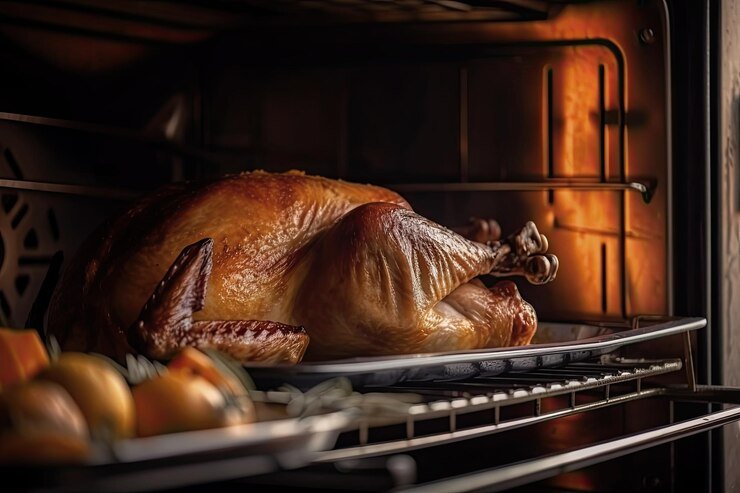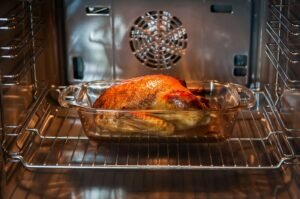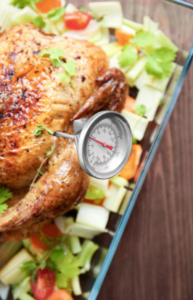Overview of Chicken Roasting
Roasting chicken is one of those kitchen tasks that seems straightforward—pop it in the oven, and a bit later, you’ve got dinner. However, the difference between a good roast chicken and a great one lies in mastering the details. It’s not just about cooking; it’s about crafting a meal that’s both a delight to the palate and a feast for the eyes.
Importance of Correct Temperature in Cooking
When it comes to cooking, especially poultry, hitting the right temperature isn’t just a suggestion—it’s a must. The optimal roasting temperature ensures that your chicken isn’t just delicious but safe to eat as well. Undercooked chicken can harbor harmful bacteria, while overcooked chicken can turn unnecessarily tough and dry. Therefore, getting that perfect balance where the meat is juicy, flavorful, and safe is crucial. By sticking to the recommended temperatures, you’re not just cooking; you’re caring for the well-being of those you feed.
In the upcoming sections, we will delve deeper into the specifics of roasting temperatures, preparation techniques, and frequently asked questions to ensure that your roast chicken is nothing short of perfect. Stay tuned as we break down the science and craft behind perfectly roasted poultry.
Cooking Techniques and Tips
Preparing the Chicken for Roasting
Before you even preheat the oven, proper preparation of your chicken is key to achieving that perfectly roasted finish. Start by patting the chicken dry with paper towels; this helps to ensure the skin will crisp up nicely. Season the cavity generously with salt and pepper, and if you like, stuff it with aromatics like garlic, lemon halves, or fresh herbs. These not only flavor the meat but also help to keep it moist during cooking. Trussing the legs together and tucking the wing tips under the body are small steps that promote even cooking and prevent overcooking the thinner parts.
Roasting Equipment and Utensils
The right tools can make a big difference in your roasting outcome. A heavy-duty roasting pan that comfortably fits the chicken without crowding it is ideal. This allows heat to circulate evenly around the bird. Using a roasting rack within the pan elevates the chicken, allowing the hot air to circulate underneath, which contributes to an evenly cooked, crispy skin all around. Additionally, having a high-quality oven thermometer on hand ensures that you’re cooking your chicken at the precise temperature, regardless of oven hot spots or calibration issues.
Step-by-Step Roasting Process
Once your chicken is prepped and your oven is properly preheated to the right temperature—typically around 350°F for whole chickens—place the chicken breast-side up in the pan. Roast according to size and weight, generally about 20 minutes per pound, until the skin is golden brown and a thermometer inserted into the thickest part of the thigh reads 165°F. Basting isn’t always necessary, but if you choose to do it, do so sparingly to avoid losing heat from the oven by opening it frequently. When your chicken is done, let it rest for at least 10-15 minutes before carving. This resting period allows the juices to redistribute, ensuring your chicken is moist and flavorful when sliced.
With these techniques in hand, you’re set to roast a chicken that’s not just cooked but is culinarily crafted to be a centerpiece at your table. For additional insights and expert tips on chicken temperatures and cooking times, check out this comprehensive guide to chicken temperatures at Webstaurant Store.
FAQs on Roasting Chicken
What is the best temperature for roasting a chicken
One of the most common questions about roasting chicken is, « What is the best temperature for roasting a chicken? » Well, it’s not just about time—it’s about the temperature and size of your chicken. As a rule of thumb, a whole chicken needs about 20 minutes per pound in an oven set to 350°F. However, the best way to be sure your chicken is perfectly roasted is to use a meat thermometer. Aim for an internal temperature of 165°F in the thickest part of the thigh, not touching the bone.
How to Tell if Chicken is Cooked Properly?
Ensuring your chicken is cooked properly is crucial for both safety and enjoyment. The foolproof method is to use a digital meat thermometer. The internal temperature should reach 165°F. Additionally, the juices should run clear when you pierce the thigh with a knife. If the juices are pinkish or red, your chicken needs more time. Remember, the thigh is the last part to cook through, so always test it there.
Tips for Keeping Chicken Moist and Flavorful
Nobody enjoys dry chicken. To keep your roasted chicken moist and flavorful, consider brining it beforehand. Brining in a saltwater solution can help increase the moisture content of the chicken. Another tip is to roast your chicken at a higher temperature for the first 10-15 minutes to lock in the juices and then lower the temperature to finish cooking. Lastly, let your chicken rest covered in foil for about 10-15 minutes after taking it out of the oven. This rest period allows the juices to redistribute throughout the meat, making it juicier and more flavorful when you cut into it.
These FAQs provide a handy guide for both newbie cooks and seasoned kitchen pros. Remember, practice makes perfect, and each chicken you roast will teach you a little more about perfecting this culinary art.
Advanced Techniques and Considerations
Using Thermometers for Precision
A trusty meat thermometer is a chef’s best friend when it comes to roasting chicken. While the universal safe internal temperature is 165°F, using a thermometer allows you to check not just for safety but for perfection. Insert the thermometer into the thickest part of the thigh, avoiding the bone, to get the most accurate reading. This ensures that you’re not overcooking the breast while trying to get the thigh up to temperature, which is a common mistake.
Resting Time Post-Roasting
Once your chicken is out of the oven, the temptation to cut into it right away can be overwhelming. However, patience pays off here. Allowing the chicken to rest for about 10 to 15 minutes will enable the juices to settle and redistribute throughout the meat. This means when you do slice into your chicken, the juices will be retained inside the meat, not running out onto your cutting board, resulting in a moister, more flavorful meal.
Adjustments for Different Oven Types
Not all ovens are created equal. Conventional ovens might cook differently than convection ovens, which circulate air and can reduce cooking time. If you’re using a convection oven, reduce the cooking temperature by about 25 degrees, or shorten the cooking time by roughly 20%. Keep a close eye on the roast, as the circulating air can cause quicker browning and crisping. Understanding the quirks of your oven can prevent common roasting pitfalls, like uneven cooking or dry meat.
Mastering these advanced techniques will not only ensure a perfectly roasted chicken every time but will also elevate your overall cooking skills. Remember, each chicken and oven is unique, and adjustments might be necessary to achieve that ideal roast.
Recommended Internal Links
- Article Title: « Juicy Roasted Chicken »
- URL: Juicy Roasted Chicken
- Embed Link in Phrase: « perfectly cooked poultry »
- Suggested Link: For tips on achieving perfectly cooked poultry, check out our guide on Juicy Roasted Chicken.
- Article Title: « What is traditionally served with Chicken Marsala »
- URL: What is traditionally served with Chicken Marsala
- Embed Link in Phrase: « complementary side dishes »
- Suggested Link: Explore complementary side dishes that go well with chicken dishes.
- Article Title: « Chicken Cutlet Recipes »
- URL: Chicken Cutlet Recipes
- Embed Link in Phrase: « variations on chicken »
- Suggested Link: For more variations on chicken, check out our delicious chicken cutlet recipes.
Additional Resources and Readings
- Link: ThermoWorks Blog on Chicken Internal Temperatures
- Embed in Phrase: « using a thermometer »
- Suggested Implementation: For a deeper understanding of why and how to correctly use a thermometer when roasting chicken, see this detailed guide from ThermoWorks.
- Link: FoodSafety.gov on Safe Minimum Internal Temperatures
- Embed in Phrase: « safe minimum internal temperature »
- Suggested Implementation: Learn more about the safe minimum internal temperature for chicken and other foods at FoodSafety.gov.
- Link: Food Network on What Temperature Is Chicken Done
- Embed in Phrase: « the recommended safe internal temp for chicken is 165°F »
- Suggested Implementation: For additional insights on cooking temperatures and food safety, visit this Food Network article.



